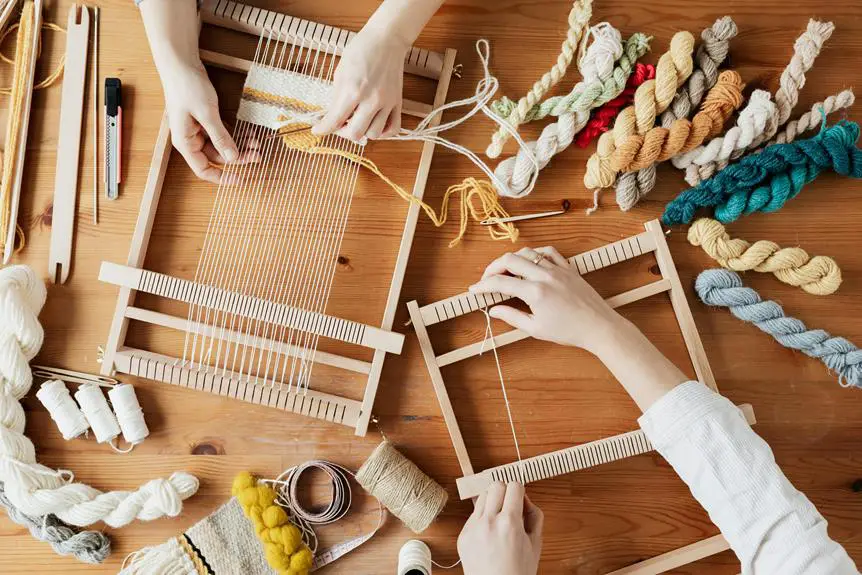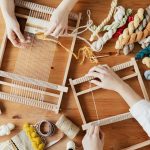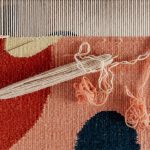When it comes to crafting fabrics, finding the right table loom is like picking the perfect tool for your masterpiece.
Each loom has its own unique features and capabilities, so choosing the best one for your crafting needs is essential.
Let's dive into the world of table looms and explore which one will elevate your fabric crafting to the next level.
Key Takeaways
- Jack looms are a suitable choice for beginners due to their simple construction.
- When selecting a table loom, consider factors such as portability, material tension adjustment, threading technique, and maximum weaving width.
- For beginners, a compact and lightweight loom with clear instructions and essential accessories is recommended.
- Advanced weavers should look for table looms with multi-shaft capabilities, durable construction, precise tension control, and quick shaft changing mechanisms.
Understanding Table Loom Types
When choosing a table loom for crafting fabrics, understanding the different table loom types available can help you make an informed decision. Loom construction plays a crucial role in determining the type of weaving techniques you can employ. The most common table loom types are jack looms, countermarch looms, and counterbalance looms, each with its unique construction and capabilities.
Jack looms are known for their simplicity in construction, making them ideal for beginners. They operate by lifting individual harnesses using a series of interconnected treadles, allowing for a wide range of weaving techniques.
On the other hand, countermarch looms feature a more complex construction, utilizing a system of cords and pulleys to control the harnesses. This design results in a balanced and stable shed, enabling intricate weaving patterns and designs.
Lastly, counterbalance looms rely on a simple construction where each harness is connected to a corresponding lower and upper lamm, allowing for smooth and consistent weaving.
Understanding the construction of these table loom types is essential for determining which one aligns with your weaving techniques and fabric crafting needs.
Key Features to Consider
Consider important features such as harnesses, shedding mechanism, and weaving width when selecting a table loom for crafting fabrics.
Loom portability and storage are crucial, especially if you have limited space or need to transport the loom. Look for a table loom that can be easily folded or disassembled for convenient storage and transportation.
Material tension is another key feature to consider. The ability to adjust and maintain proper tension ensures consistent and high-quality weaving results.
Additionally, pay attention to the threading technique the loom utilizes. Some table looms offer features like a vertical heddle movement or a dobby mechanism, which can affect the ease of threading and the complexity of patterns you can create.
When evaluating a potential table loom, take note of the maximum weaving width it offers. A wider weaving width provides more flexibility in the size of fabrics you can create.
Best Table Loom for Beginners
If you're new to weaving, finding the right table loom can make all the difference in your crafting journey.
Let's talk about what makes an ideal table loom for beginners and explore some entry-level options that are user-friendly and versatile.
Whether you're looking for ease of use or want to start with a budget-friendly choice, there's a table loom out there that's perfect for you.
Ideal Beginner Table Loom
How do you choose the best table loom for beginners when starting your fabric crafting journey?
As a beginner weaver, it's essential to find a table loom that's user-friendly and versatile. Here are some key factors to consider when selecting the ideal beginner table loom:
- Size and Portability
Look for a compact and lightweight loom that's easy to transport and store, making it perfect for beginners with limited space.
- Ease of Use
Choose a loom with clear instructions and straightforward assembly to ensure a smooth learning experience.
- Loom Accessories
Consider a table loom that comes with essential accessories such as a reed and heddles, providing everything you need to start weaving right away.
Selecting the right beginner table loom will lay a solid foundation for your weaving journey.
Entry-Level Table Looms
To find the best table loom for beginners, start by researching entry-level options that offer user-friendly features and essential accessories for a smooth weaving experience. Look for looms that come with helpful accessories like shuttles, a warping peg, and a reed hook to assist with various weaving techniques.
When considering entry-level table looms, prioritize ones that are straightforward to assemble and operate. Look for models that include clear instructions for loom assembly and troubleshooting tips to address common issues that beginners may encounter.
Additionally, seek out looms that come with online resources or beginner-friendly guides to help you master the art of weaving. By choosing an entry-level table loom with these features, you can embark on your weaving journey with confidence and ease.
Top Table Loom for Advanced Weavers
For advanced weavers, efficiency is paramount when selecting a table loom. When considering a top table loom, it's essential to look for features that cater to advanced techniques and specialized projects. Here are some important factors to consider when choosing a table loom for advanced weaving:
- Versatility: Look for a table loom that offers a wide range of weaving options, such as multi-shaft capabilities and the ability to handle complex weave structures. This versatility allows you to explore advanced weaving techniques and create intricate designs with ease.
- Durability: Advanced weavers often work on larger and more complex projects, so durability is key. Choose a table loom constructed from high-quality materials that can withstand the rigors of advanced weaving techniques and prolonged use.
- Ease of Adjustment: A top table loom for advanced weavers should offer precise tension control, easy treadle adjustments, and quick shaft changing mechanisms. These features streamline the weaving process, allowing you to focus on honing your advanced skills without being hindered by cumbersome adjustments.
Selecting the right table loom tailored for advanced weavers can significantly enhance your weaving experience, enabling you to tackle challenging projects with finesse and efficiency.
Comparing Table Loom Sizes
When choosing a table loom, size matters. Small looms are great for portability, while larger ones offer more weaving capacity.
Consider the space you have available and how you plan to use the loom to determine which size best suits your crafting needs.
Small Vs. Large Looms
When choosing between small and large table looms, consider the specific weaving projects you plan to undertake. Small looms are ideal for creating intricate designs due to their compact size and fine sett capabilities. They're perfect for weaving delicate patterns and smaller projects, such as scarves, napkins, or small decorative pieces.
However, if you're planning to craft larger items like shawls, blankets, or wide fabric panels, a large loom would be more suitable as it offers a greater weaving width and versatility. Additionally, large looms provide more space for experimenting with complex weave structures and allow you to work on multiple projects simultaneously.
Ultimately, the choice between small and large looms depends on the scale and intricacy of your weaving endeavors.
Portability and Space
Considering your weaving needs, evaluating the portability and space requirements of different table loom sizes is essential for making an informed choice. Table looms come in various sizes, each offering unique portability options and space-saving designs. Here's a comparison of common table loom sizes to help you assess their portability and space requirements:
| Table Loom Size | Portability Options | Space Saving Design |
|---|---|---|
| Small | Lightweight and often foldable, making them highly portable | Ideal for small living spaces or for weavers with limited room |
| Medium | Moderately portable and can be moved with some effort | Offers a balance between portability and weaving width |
| Large | Less portable due to their size and weight | Suitable for dedicated weaving spaces with ample room for loom setup |
Understanding the portability and space-saving features of different table loom sizes will help you choose the right one to meet your weaving needs.
Weaving Capacity
To assess the weaving capacity of different table loom sizes, compare their maximum weaving widths and potential for intricate fabric designs. When considering table loom sizes, it's essential to evaluate the weaving techniques you plan to use and the yarn selection for your projects.
Here are some key factors to consider:
- Maximum Weaving Width:
- Larger table looms typically offer wider weaving widths, allowing you to create larger fabric pieces in one go.
- Smaller table looms may have limitations on the maximum weaving width, making them more suitable for smaller projects and intricate designs.
- Weaving Techniques:
- Consider the weaving techniques you intend to use, as certain techniques may require a wider weaving width to accommodate their specific patterns and designs.
- Yarn Selection:
- Different table loom sizes may be better suited for specific yarn weights, with larger looms accommodating thicker yarns and smaller looms being more suitable for finer yarns.
Evaluating Material Compatibility
You'll want to assess the material compatibility of each table loom before making your selection. Material compatibility refers to the ability of a table loom to effectively handle different types of fibers and yarns.
When evaluating material compatibility, consider the weaving techniques you plan to use as well. Some table looms are better suited for certain materials and techniques than others.
For example, if you intend to work with bulky or textured yarns, you'll need a table loom with a wider shed and a sturdy frame to accommodate the thicker materials.
Additionally, if you plan to weave intricate patterns using fine threads, a table loom with a higher level of tension control and a finer sett capability would be more suitable.
It's essential to ensure that the table loom you choose can effectively manage the specific materials and weaving techniques you intend to use for your projects.
Maintenance and Longevity Considerations
When maintaining your table loom for longevity, it's important to regularly clean and lubricate its moving parts to prevent wear and ensure smooth operation. Additionally, consider the material of your loom as it can impact maintenance and longevity.
Here are some considerations for loom material comparison:
- Wooden Looms
- Regularly polish and treat the wood to prevent warping or splintering.
- Keep the loom in a stable environment to avoid excessive expansion or contraction due to humidity.
- Metal Looms
- Clean metal parts to prevent corrosion and rust.
- Apply a light coat of oil to protect against moisture and ensure smooth movement.
- Plastic Looms
- Use mild cleaning agents to avoid damaging the material.
- Store the loom away from direct sunlight to prevent brittleness and fading.
Frequently Asked Questions
What Are the Best Table Loom Brands for Crafting Fabrics?
When considering the best table loom brands for crafting fabrics, it's important to explore various weaving techniques and material compatibility. Researching reputable brands, seeking recommendations, and experimenting with different looms can help refine your fabric crafting skills.
Can Table Looms Be Used for Creating Intricate Patterns and Designs?
Yes, table looms can be used for creating intricate patterns and designs. You can weave using multiple colors, experiment with textures, and incorporate unique materials to achieve the mastery you desire in your crafting.
Are There Specific Table Looms Recommended for Weaving With Different Types of Yarn or Thread?
When choosing a table loom, consider compatibility with different yarn or thread types. Some looms are better suited for specific materials, so it's important to match the loom to your desired fabric and design.
How Important Is the Portability of a Table Loom for Crafting Fabrics?
Portability is crucial for crafting fabrics, enabling you to weave in different spaces. A versatile table loom saves space and allows for crafting on the go. Prioritize portability when selecting a table loom for your fabric crafting needs.
Are There Any Special Accessories or Attachments That Can Enhance the Crafting Experience With a Table Loom?
Using special attachments can enhance your crafting experience with a table loom. They can elevate your weaving techniques, introduce crafting innovations, and streamline loom maintenance and fabric finishing techniques, offering a comprehensive and efficient crafting process.
- How Does Ring Spun Cotton Affect Garment Fit and Shape Retention? - August 13, 2024
- What Are the Challenges in Producing Ring Spun Cotton? - August 13, 2024
- Is Ring Spun Cotton Suitable for Plus-Size Clothing? - August 13, 2024







